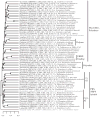Computational identification and analysis of orphan assembly-line polyketide synthases
- PMID: 24301183
- PMCID: PMC4028714
- DOI: 10.1038/ja.2013.125
Computational identification and analysis of orphan assembly-line polyketide synthases
Abstract
The increasing availability of DNA sequence data offers an opportunity for identifying new assembly-line polyketide synthases (PKSs) that produce biologically active natural products. We developed an automated method to extract and consolidate all multimodular PKS sequences (including hybrid PKS/non-ribosomal peptide synthetases) in the National Center for Biotechnology Information (NCBI) database, generating a non-redundant catalog of 885 distinct assembly-line PKSs, the majority of which were orphans associated with no known polyketide product. Two in silico experiments highlight the value of this search method and resulting catalog. First, we identified an orphan that could be engineered to produce an analog of albocycline, an interesting antibiotic whose gene cluster has not yet been sequenced. Second, we identified and analyzed a hitherto overlooked family of metazoan multimodular PKSs, including one from Caenorhabditis elegans. We also developed a comparative analysis method that identified sequence relationships among known and orphan PKSs. As expected, PKS sequences clustered according to structural similarities between their polyketide products. The utility of this method was illustrated by highlighting an interesting orphan from the genus Burkholderia that has no close relatives. Our search method and catalog provide a community resource for the discovery of new families of assembly-line PKSs and their antibiotic products.
Figures






References
-
- Hertweck C. The biosynthetic logic of polyketide diversity. Angew Chem Int Ed. 2009;48:4688–4716. - PubMed
-
- Hopwood DA. Genetic contributions to understanding polyketide synthases. Chem Rev. 1997;97:2465–2497. - PubMed
-
- Katz L. Manipulation of modular polyketide synthases. Chem Rev. 1997;97:2557–2575. - PubMed
-
- Khosla C, Tang Y, Chen AY, Schnarr NA, Cane DE. Structure and mechanism of the 6-deoxyerythronolide B synthase. Annu Rev Biochem. 2007;76:195–221. - PubMed
-
- Donadio S, Staver MJ, McAlpine JB, Swanson SJ, Katz L. Modular organization of genes required for complex polyketide biosynthesis. Science. 1991;252:675–679. - PubMed
Publication types
MeSH terms
Substances
Grants and funding
LinkOut - more resources
Full Text Sources
Other Literature Sources
Medical
Research Materials
Miscellaneous

